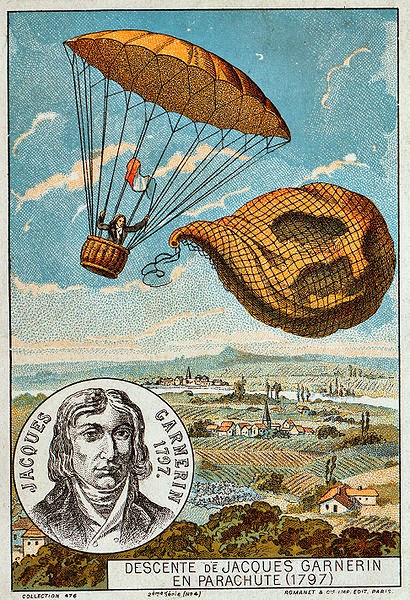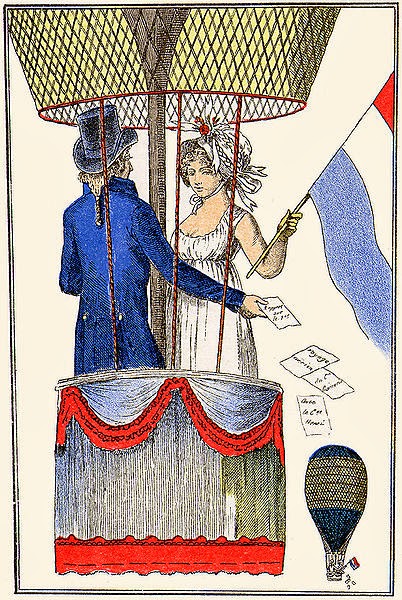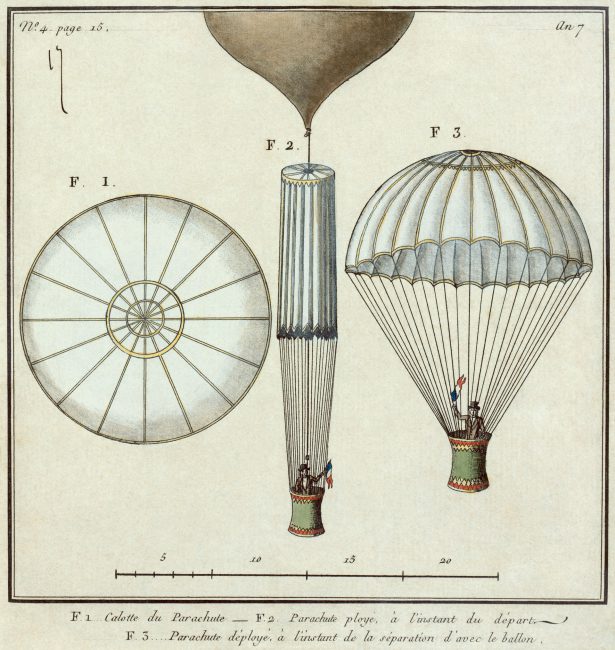
André-Jacques Garnerin releases the balloon and descends with the help of a parachute, 1797. Illustration from the late 19th century.
On October 22, 1797, French balloonist and inventor André Garnerin, made the first safe descent with a silk parachute from a ballon at Parc Monceau, Paris.
Bold Garnerin went up
Which increased his Repute
And came safe to earth
In his Grand Parachute.
André Garnerin
André-Jacques Garnerin was baptized on January 31, 1769 in the church of Saint-Sauveur in Paris, France. He later became a student of Jaques Charles. Charles was a well known ballooning pioneer and launched along with the Robert brothers the very first unmanned hydrogen filled balloon in 1783. He also started experimenting with manned flights, just like Garnerin later, who was then announced Official Aeronaut of France.
A Balloonist
Garnerin made his first balloon flight from Metz in 1787. Three years later, he took off in a simple hot air balloon. During the Coalition Wars, Garnerin was assigned to conduct negotiations with the Allies, who threatened France from all sides. However, since the French Republic was not officially recognized by its enemies, he was imprisoned in the Buda Fortress for three years. During his imprisonment, Garnerin occupied himself with designing parachutes that would help him escape.
Citoyenne Henri – the first female passenger
Garnerin received quite a lot of attention, especially when he announced that on the next flight, his passenger would be a woman. By governmental officials, Garnerin was then questioned about this project and it was highly doubted that a woman should be on his flight due to the concerns that reduced air pressure might effect her inner organs. However, after the Minister of Interior and the Minister of the Police discussed this topic, it was found that it should no longer be a scandal when two people of different sexes ascend in a balloon together, also the chosen woman was completely aware of the possible health risks. The chosen one was Citoyenne Henri and she became known as the first woman “who ever had the courage to trust herself in the regions of air“. This is interesting since she was not even the first woman to fly in a balloon. There are three known women, who achieved this before in Paris. Garnerin and his first female passenger ascended into the sky towards the north of Paris and landed shortly after without any incident.

Citoyenne Henri accompanies Garnerin on a highly publicised and
controversial flight
The Parachute Experiment
With his experience in ballooning, Garnerin started experimenting with umbrella-shaped parachutes. Already Leonardo da Vinci wrote in detail about his ideas of a parachute device. However, it was André Garnerin, who performed the first parachute descent from a balloon over Parc Monceau in Paris with a device made of silk on October 22, 1797 in Paris. His construction was basically a closed umbrella with a pole running down in the middle. He attached a basket to it and at an altitude of about 400 metres, he severed the rope that connected his parachute to the balloon. Since there was no opening at the apex of his parachute, the compressed air flowed over the edge of the chute and caused dangerous, strong pendulum movements. His balloon continued its journey into the skies while he fell with his parachute downwards. Even though the landing was very rough, Garnerin was not injured and his first silk parachute flight was a success. He landed in front of a crowd admiring him and was brought to the city in triumph. At the suggestion of astronomer Jérôme Lalande, Garnerin attached a parachute apex opening five years later.[8]

Schematic depiction of Garnerin’s first parachute used in the Parc Monceau descent of 22 October 1797. Illustration dates from the early nineteenth century.
Jeanne-Geneviève Labrosse
Jeanne-Geneviève Labrosse was the wife of André-Jacques Garnerin. On November 10, 1798, she became the first woman in the world to ride a balloon. On October 12, 1799, she became the first woman in the world to make a parachute descent from a height of 900 meters using the parachute developed by her husband. The parachute was attached to the gondola of the balloon, which sank to the ground after the balloon envelope was separated with Labrosse on board. On 11 October 1802, she filed a patent application on behalf of her husband for: “a device called a parachute, intended to slow the fall of the basket after the balloon bursts. Its vital organs are a cap of cloth supporting the basket and a circle of wood beneath and outside of the parachute and used to hold it open while climbing: it must perform its task at the moment of separation from the balloon, by maintaining a column of air.
Later Life
On October 3 and 4, 1803, Garnerin covered a distance of 300 km between Moscow and Polova by balloon. He completed a 395 km balloon flight between Paris and Clausen near Pirmasens on November 22 and 23, 1807. The balloon and parachute pioneer made the unforeseen emergency landing when he realized that his long-distance flight from Paris to Switzerland had become an aberration. During the emergency landing, his gondola was slightly damaged. The balloon envelope and gondola were taken from Clausen to Zweibrücken by horse and cart. From there, Garnerin and his equipment started their journey home to Paris by stagecoach.
Garnerin died in an accident in 1823 while filling a balloon in Paris; he was struck by a beam.
Felix Baumgartner’s supersonic freefall from 128k’ – Mission Highlights, [9]
References and Further Reading:
- [1] Monsieur Garnerin drops in at History Today
- [2] Defying Gravity: Land Divers, Roller Coasters, Gravity Bums, and the Human Obsession with Falling
- [3] Around the World in 175 Days, SciHi Blog
- [4] Louis Blèriot’s famous Flight across the English Channel, SciHi Blog
- [5] Otto Lilienthal – The Glider King , SciHi Blog
- [6] More than just hot air – the Montgolfier-Balloons , SciHi Blog
- [7] Around the World in A Balloon , SciHi Blog
- [8] Jérôme Lalande – Astronomer in Times of the Enlightenment and the French Revolution, SciHi Blog
- [8] Garnerin at Wikidata
- [9] Felix Baumgartner’s supersonic freefall from 128k’ – Mission Highlights, Red Bull @ youtube
- [10] Timeline of Aviation Pioneers via DBpedia and Wikidata





